Follow Us:
Share
Table of Contents:
The Northrop YF-23 Black Widow II was one of the most advanced and stealthiest fighter jets ever developed. Designed to compete with the YF-22 for the U.S. Air Force’s Advanced Tactical Fighter (ATF) program, the Northrop YF 23 was a groundbreaking aircraft that demonstrated cutting-edge technology and innovation.
Although the YF-23 did not win the competition, it has left an enduring legacy in the world of aviation, admired for its unique design, stealth capabilities, and speed.
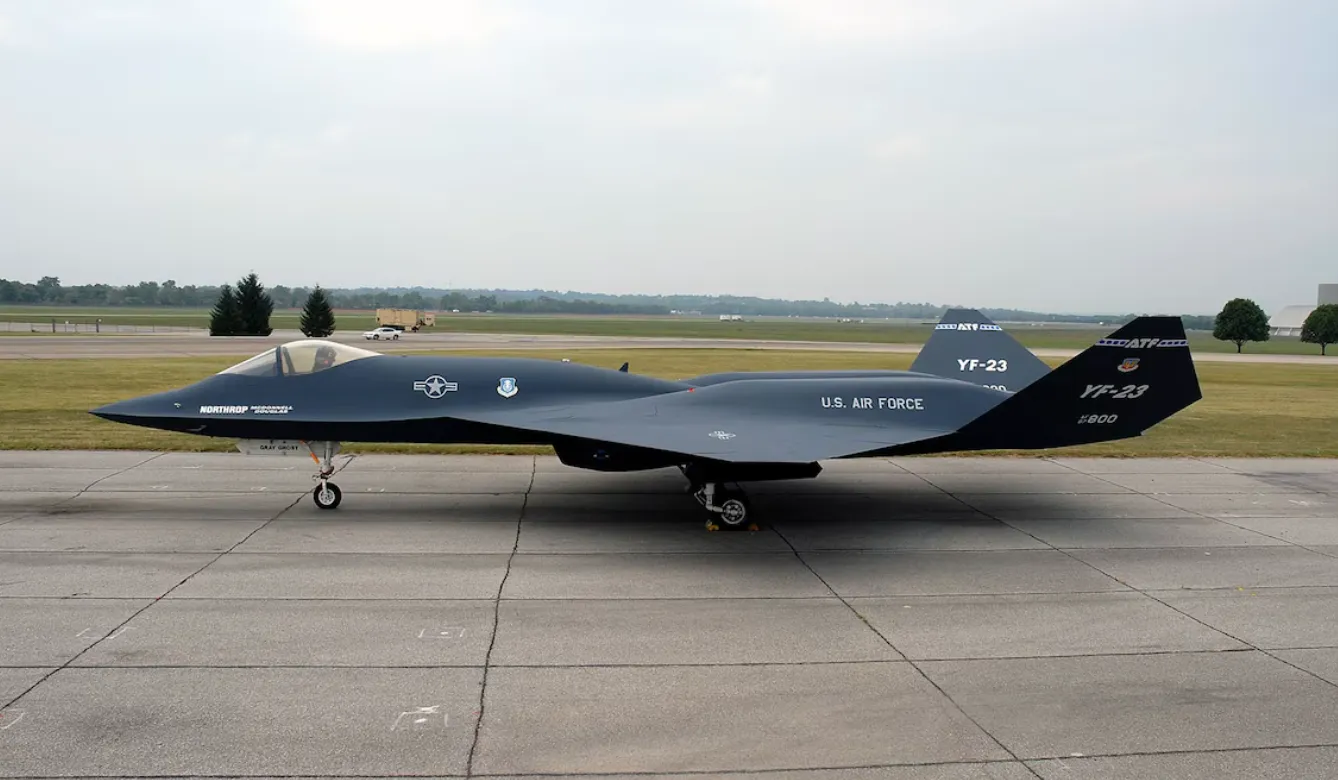
In this comprehensive guide, we’ll explore every aspect of the Northrop YF 23, from its development history and design features to its role in the ATF program and its influence on future aircraft.
Whether you’re an aviation enthusiast or just curious about military fighter jets, this article will provide an in-depth look at one of the most fascinating aircraft ever created.
History and Development of the Northrop YF-23
The Northrop YF-23 was born out of the U.S. Air Force’s need for a next-generation air superiority fighter to replace the aging fleet of F-15 Eagles and F-16 Fighting Falcons.
The Advanced Tactical Fighter (ATF) program was initiated in the early 1980s, driven by the need for a highly maneuverable, stealthy aircraft capable of engaging Soviet fighters and bombers.
The goal was to develop an aircraft with superior speed, stealth, and survivability—the three pillars of the ATF program.
Northrop Corporation, in collaboration with McDonnell Douglas, entered the competition with their YF-23 design, while Lockheed Martin (teamed with Boeing and General Dynamics) submitted the YF-22.
The YF-23 quickly gained attention for its unconventional shape and stealth-first design philosophy, which set it apart from the YF-22.
Timeline of Development
- 1981: The ATF program is initiated.
- 1986: Contracts are awarded to both Northrop and Lockheed to develop prototypes.
- 1990: The YF-23 makes its first flight on August 27, 1990.
- 1991: After rigorous testing, the YF-22 is selected as the winner of the ATF competition.
The YF-23, with its sleek, stealthy design, was built to reduce its radar signature while maintaining high-speed capabilities.
While both the YF-23 and YF-22 excelled in different areas, the YF-22’s superior maneuverability and dogfighting capabilities played a significant role in its selection over the YF-23.
Key Players in the Development
- Northrop Corporation: Lead designer and manufacturer of the YF-23.
- McDonnell Douglas: Partnered with Northrop, providing expertise in aircraft systems and engineering.
- Pratt & Whitney and General Electric: Both companies provided engine prototypes that were tested on the two YF-23 variants.
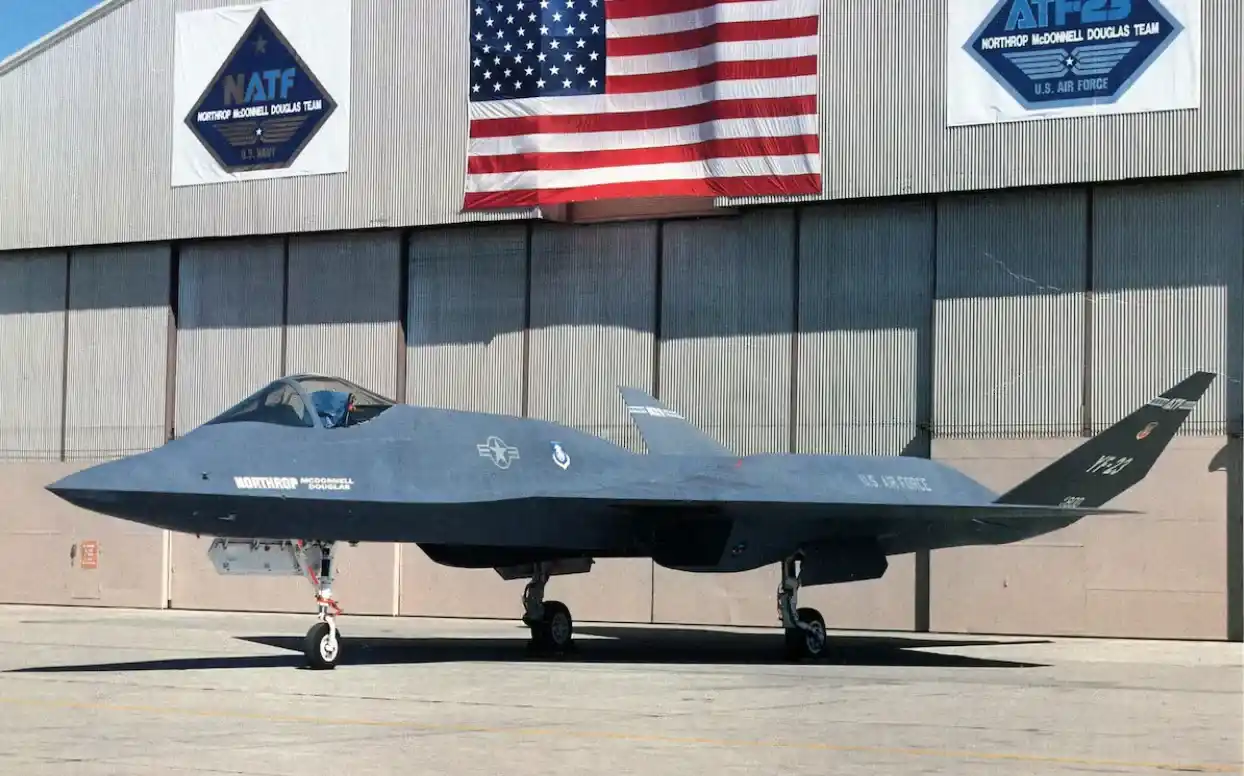
The Northrop YF-23 Black Widow II was revolutionary, not just in its physical appearance but also in the advanced technologies it brought to the table. Its stealth capabilities were ahead of their time, and its speed and efficiency made it a formidable competitor.
However, the YF-22’s edge in agility, combined with factors like political support and production readiness, led to its ultimate selection as the Air Force’s next-generation fighter.
Design and Features of the YF-23
The Northrop YF-23 Black Widow II was a marvel of advanced engineering, distinguished by its radical design and stealth-focused features.
Its unique shape, engine configuration, and overall design philosophy made it one of the most innovative aircraft of its time.
While the YF-23 did not win the ATF competition, its features are still studied and admired today for pushing the boundaries of stealth and supersonic flight.
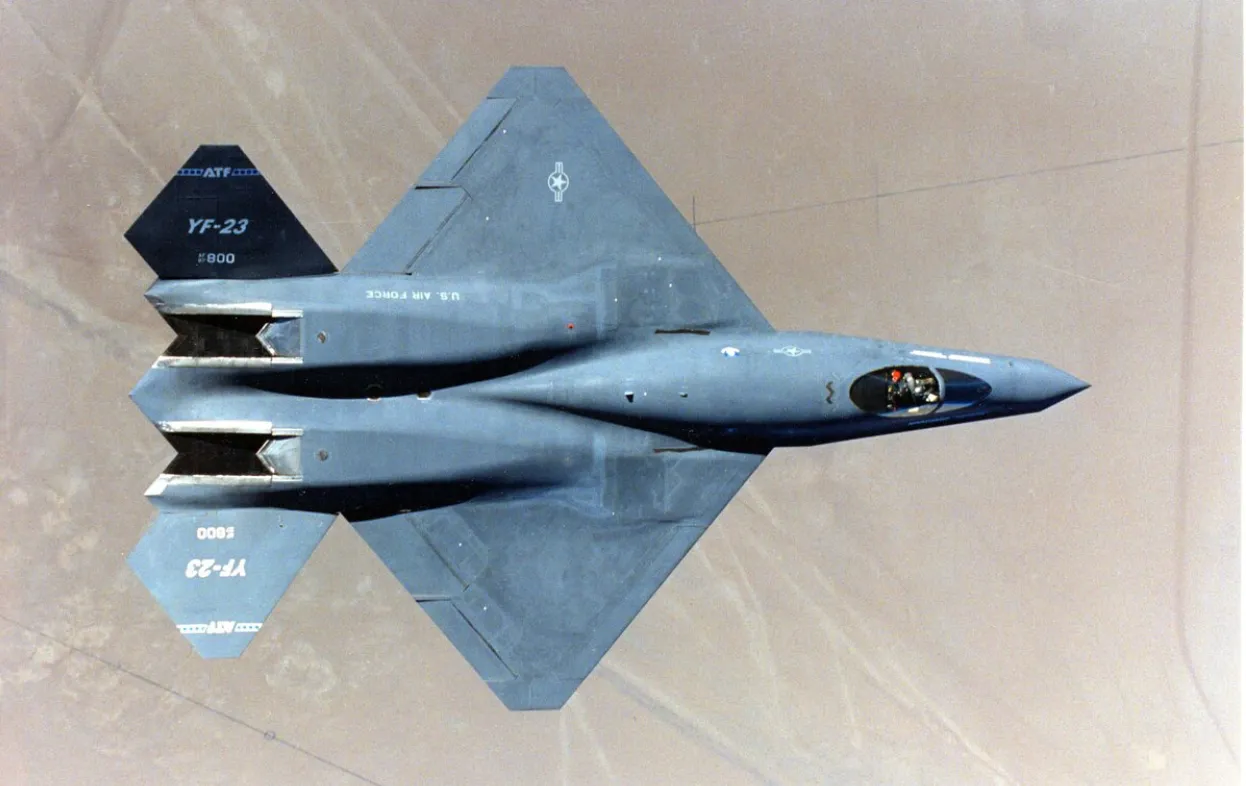
Unique Shape and Aerodynamics
One of the most striking aspects of the Northrop YF-23 was its unconventional shape. The aircraft was designed to minimize radar cross-section while still offering superior aerodynamic performance. Here’s what made its shape stand out:
- Diamond-shaped Wings: Unlike traditional fighter jets, the Northrop YF-23 featured a distinctive diamond-shaped wing configuration. This design reduced drag and allowed the jet to maintain high speeds without compromising stealth.
- V-Tail Configuration: The YF-23’s V-tail, or twin tailfins angled inward, was another key stealth feature. Traditional vertical tailfins reflect radar signals, making aircraft easier to detect.
YF-23 Cockpit and Avionics
The Northrop YF-23 cockpit was designed with the pilot’s experience in mind, featuring advanced avionics for the time, and offering a streamlined interface that allowed pilots to focus on mission objectives without being overwhelmed by complex controls.
While not as maneuverability-focused as the YF-22, the YF-23’s cockpit systems emphasized situational awareness and mission control.
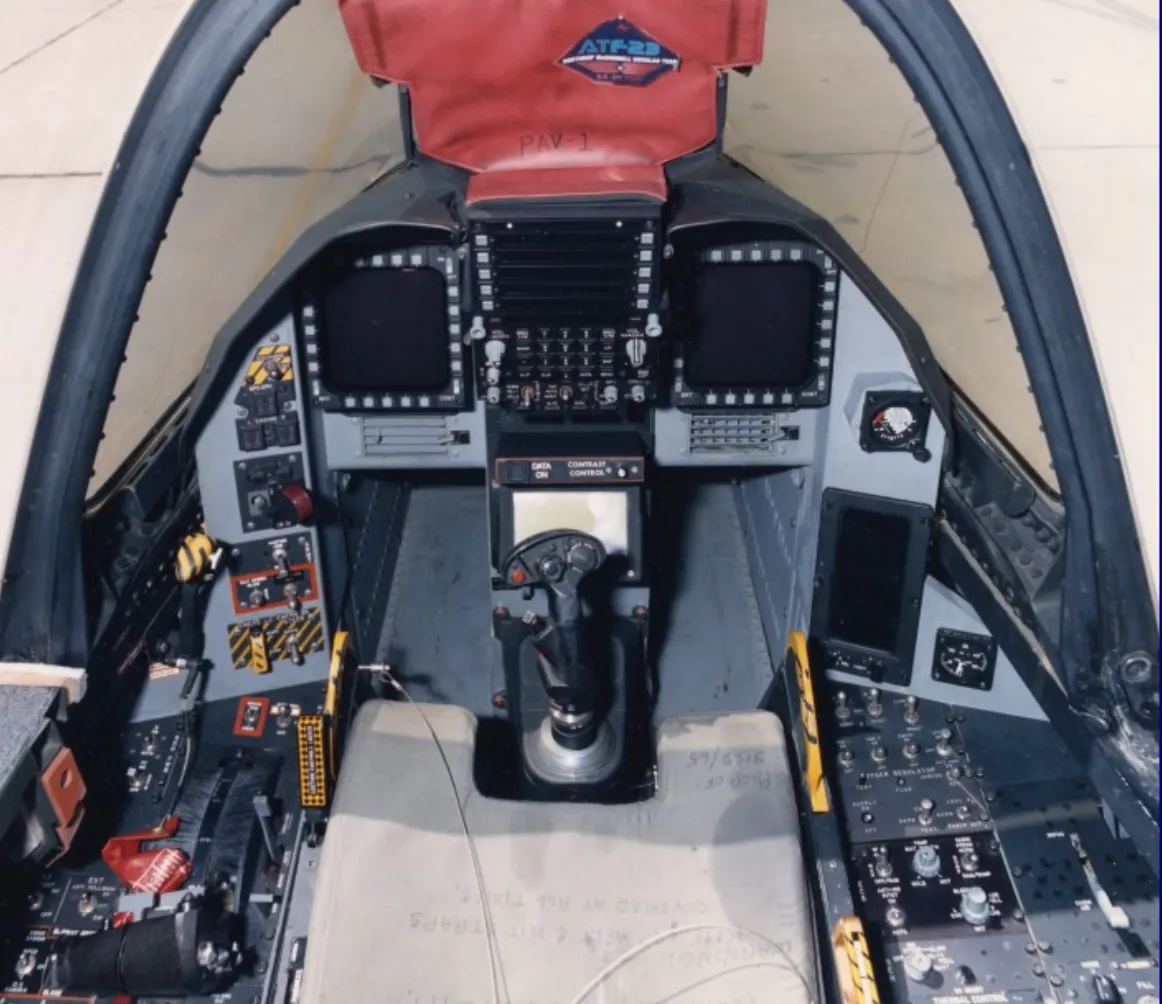
Pilot-Friendly Layout
The YF-23’s cockpit was highly advanced for its time, with cutting-edge technology that ensured the pilot had all the necessary tools to manage complex missions.
The cockpit featured a wide-angle heads-up display (HUD) that presented critical flight and combat information directly in the pilot’s line of sight.
This helped reduce the need for pilots to look down at instruments, improving situational awareness during high-speed engagements.
Additionally, the YF-23 included multi-function displays (MFDs), which allowed pilots to view radar data, sensor information, and weapons systems on one screen.
The combination of advanced avionics and ergonomic design made the Northrop YF-23 a highly effective platform for air superiority missions.
Advanced Avionics Systems
The YF-23 was equipped with sophisticated radar and sensor suites that helped it maintain its stealth profile while providing real-time data on enemy positions, weather, and mission parameters.
Although details about the avionics systems remain classified, it’s known that the aircraft was designed to integrate with state-of-the-art U.S. Air Force technologies of the 1990s, including radar-absorbing materials and advanced communication systems.
YF 23 Weapons Bay and Payload Capabilities
One of the key components of the Northrop YF-23 Black Widow II design was its internal weapons bay.
Like other stealth aircraft, the YF-23 stored all of its weapons internally to reduce its radar signature and maintain its stealth capabilities.
This feature allowed the jet to carry an impressive payload without compromising its low observability.
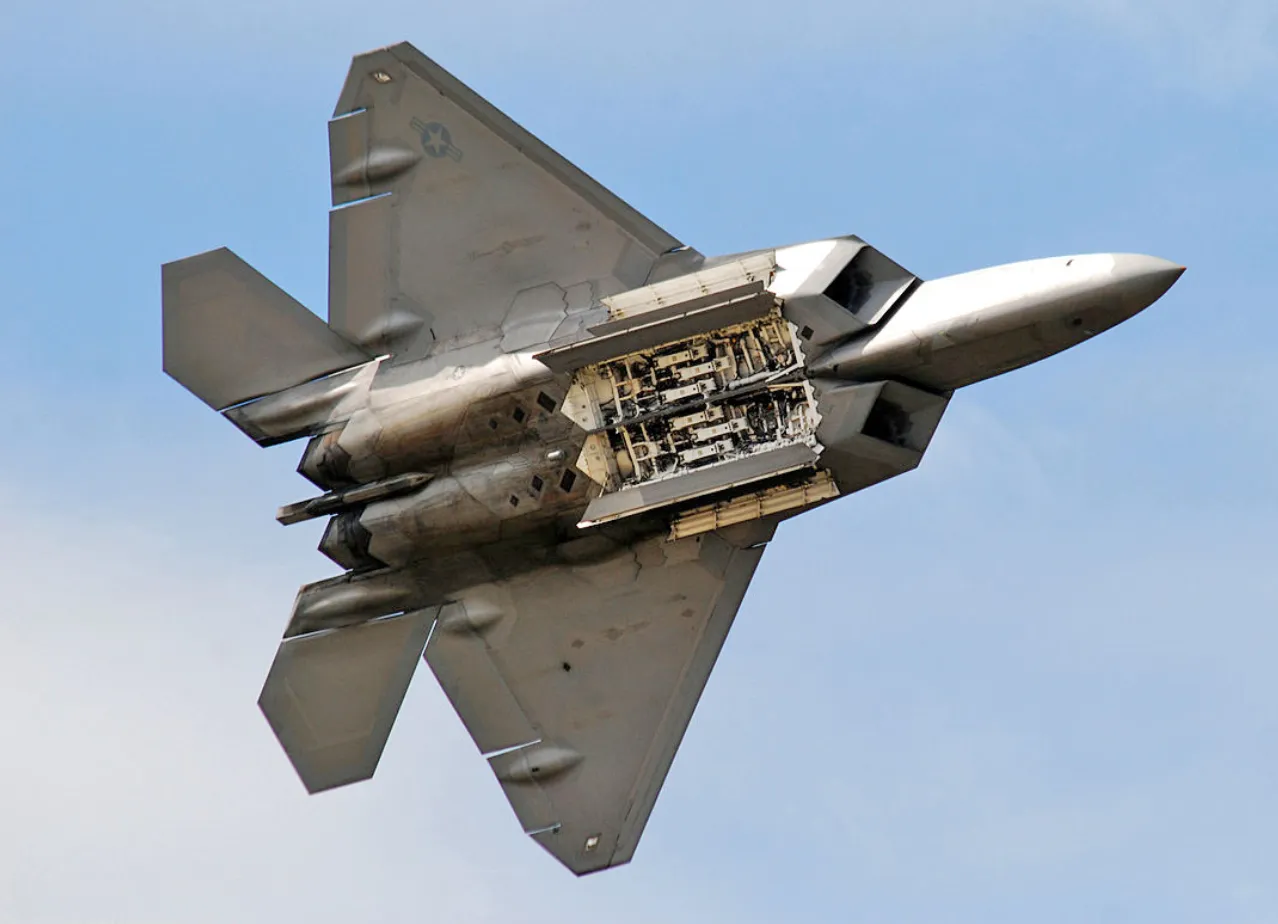
The YF-23’s weapons bay was designed to carry a variety of air-to-air missiles, all within the aircraft’s fuselage.
By storing weapons internally, the YF-23 avoided the radar reflectivity caused by external weapons pylons, a common issue in older fighter jets. The YF-23 could carry advanced air-to-air missiles, such as:
- AIM-120 AMRAAM: An advanced medium-range air-to-air missile capable of engaging targets beyond visual range.
- AIM-9 Sidewinder: A short-range, heat-seeking missile designed for close-quarters combat.

The internal weapons bay was relatively large for a fighter of its size, capable of holding up to six AIM-120 AMRAAMs or a combination of AMRAAMs and Sidewinders.
Engines and Propulsion Systems
The Northrop YF-23 was powered by two different engines during its testing phase: the Pratt & Whitney YF119 and the General Electric YF120.
These engines were cutting-edge at the time and provided the YF-23 with remarkable speed and supercruise capability.
YF-23 Engine Variants
- Pratt & Whitney YF119: A traditional, high-performance turbofan engine. It was reliable and produced a significant amount of thrust, helping the YF-23 reach speeds over Mach 2.
- General Electric YF120: A variable-cycle engine designed to switch between high-thrust and fuel-efficient modes. This engine gave the YF-23 a competitive edge in terms of speed and range. It also allowed the YF-23 to achieve supercruise—flying at supersonic speeds without using afterburners, which reduces fuel consumption and improves mission efficiency.
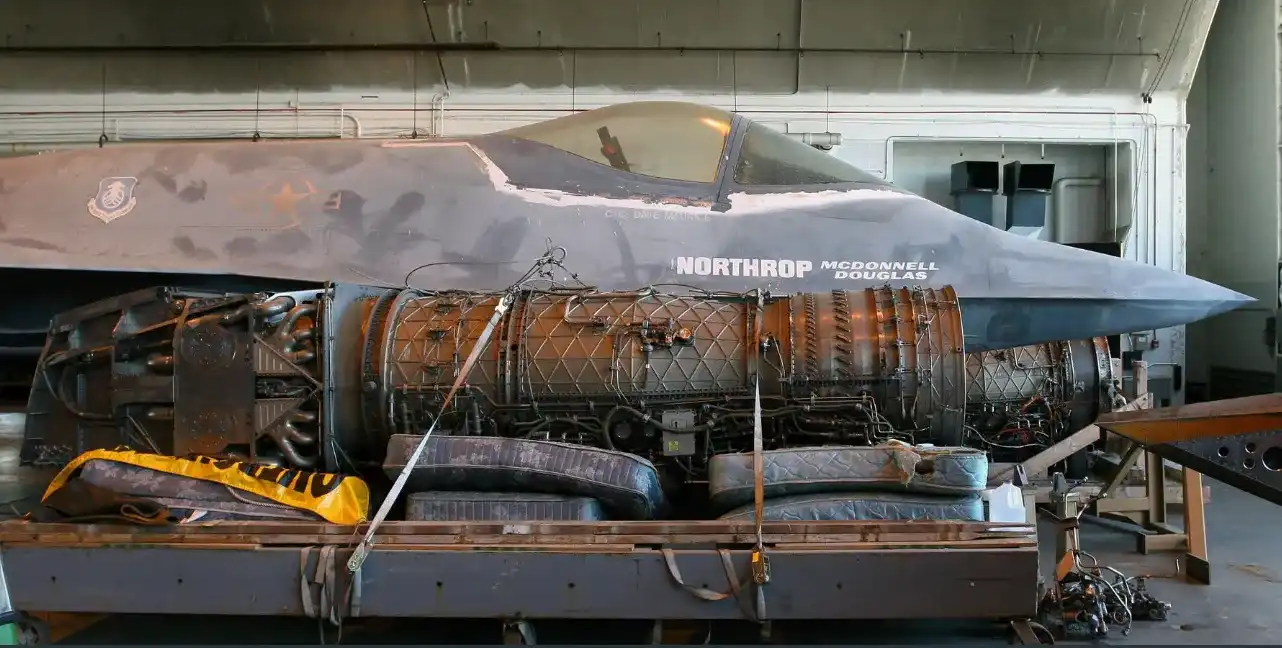
YF 23 Top Speed and Supercruise
The Northrop YF-23 Black Widow II was capable of reaching a top speed of Mach 2.2+, making it one of the fastest fighter jets of its time.
Its ability to sustain supercruise flight made it a formidable long-range interceptor, as it could maintain high speeds without the fuel penalties associated with afterburner usage.
This made the YF-23 highly suitable for long-duration air superiority missions.
Stealth Capabilities of the Northrop YF-23
The Northrop YF-23 Black Widow II was designed with stealth as one of its primary features, allowing it to fly undetected in hostile environments.
The aircraft’s groundbreaking stealth capabilities were critical to its performance, making it one of the most difficult aircraft to track using radar.
These stealth features, combined with its high speed and advanced aerodynamics, made the YF-23 a formidable competitor in the U.S. Air Force’s Advanced Tactical Fighter (ATF) program.
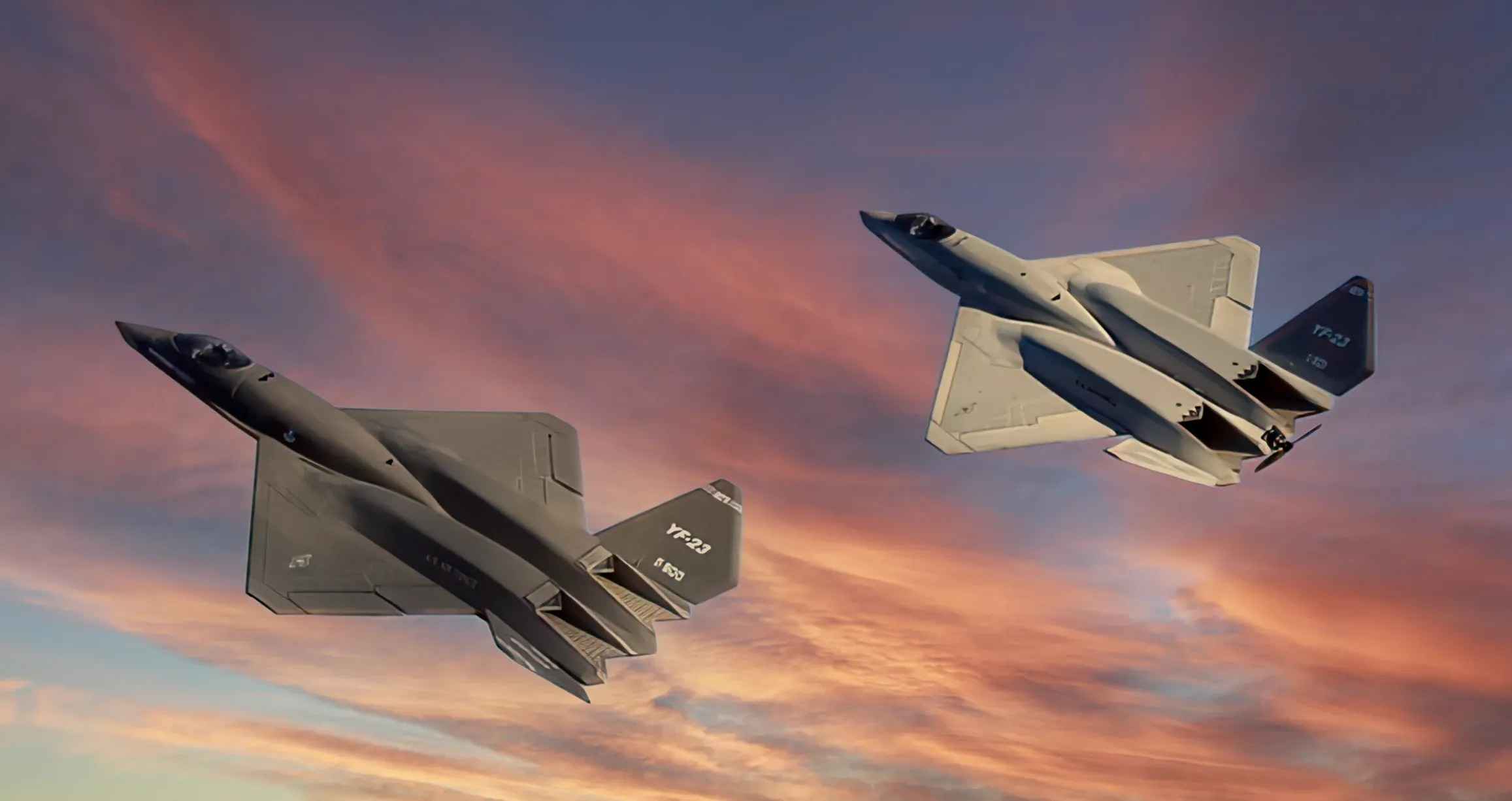
Key Stealth Features of the YF-23
- Diamond-Shaped Wings: The diamond-shaped wings of the YF-23 contributed to its reduced radar signature. These wings, paired with the aircraft’s sleek body, minimized the angles that could reflect radar waves back to the source, making it extremely difficult to detect from most angles.
- V-Tail Configuration: The V-tail design was another significant stealth feature. Traditional vertical tail fins are notorious for reflecting radar waves, which increases an aircraft’s detectability. By angling the tail fins inward, Northrop engineers were able to reduce the aircraft’s radar profile significantly.
- Recessed Air Intakes: The YF-23’s engines were buried deep inside the fuselage with recessed air intakes that prevented radar from easily bouncing off the engine blades. Engine intakes are one of the most common areas for radar reflection, so this feature greatly enhanced the YF-23’s stealth profile.
- Radar-Absorbent Materials (RAM): Like many stealth aircraft, the YF-23 was coated with radar-absorbent materials (RAM). These materials help to absorb radar waves instead of reflecting them, further reducing the chance of detection.
Comparison to the YF-22
The Northrop YF-23 was considered to have superior stealth capabilities compared to its competitor, the YF-22.
While both aircraft were designed with low observability in mind, the YF-23’s sleek and futuristic design gave it an edge when it came to reducing radar cross-section.
The YF-22, on the other hand, struck a balance between stealth and maneuverability, which meant it had a slightly larger radar signature.
YF-23 Black Widow II: Origins of the Name
The YF-23 Black Widow II carries a name steeped in history, referencing a legendary World War II aircraft and evoking the image of a stealthy, deadly predator.
The choice of the name “Black Widow” was not random—it was a tribute to the legacy of the P-61 Black Widow, an iconic night fighter used by the United States during World War II.
The addition of “II” connects the YF-23 to this storied history, indicating that this aircraft was the modern incarnation of its namesake, built to dominate the skies just as the P-61 did in its time.
The P-61 Black Widow
The P-61 Black Widow, developed by Northrop, was the first American aircraft specifically designed as a night fighter.
Introduced in 1944, it was named after the venomous black widow spider, which symbolized its deadly precision and ability to strike unseen.

The P-61 was equipped with advanced radar systems, allowing it to detect and engage enemy aircraft in total darkness—a revolutionary capability at the time.
- First Night Fighter: The P-61 was the first operational aircraft to use radar for detecting enemy planes at night or in poor weather conditions, making it a pioneering force in aerial combat technology.
- Stealth by Darkness: Although it was not stealthy in the radar sense, its night-flying capabilities made it a terror for enemy bombers and fighters that could not track it effectively.
Why the YF-23 Was Named “Black Widow II”
The Northrop YF-23 was christened the Black Widow II to honor its WWII predecessor and to highlight the stealth and lethality that were central to its design.
Like the original P-61, the YF-23 was built to engage the enemy without being detected, though this time through advanced radar-evading technologies rather than the cover of night. The “II” in the name signified its place as a successor, a modern reincarnation of the P-61’s lethal legacy.
In many ways, the YF-23 Black Widow II was designed to be the ultimate predator—fast, hard to detect, and armed to the teeth.
The name reflects both the aircraft’s lethal capabilities and the significant advancements in technology that it represented.
Northrop YF-23: Technical Specifications
The Northrop YF-23 Black Widow II was a groundbreaking aircraft with advanced technological features designed to fulfill the U.S. Air Force’s Advanced Tactical Fighter (ATF) program requirements.
While it never reached full production, the YF-23’s technical capabilities were impressive and provided a glimpse into the future of stealth and high-speed combat aircraft.
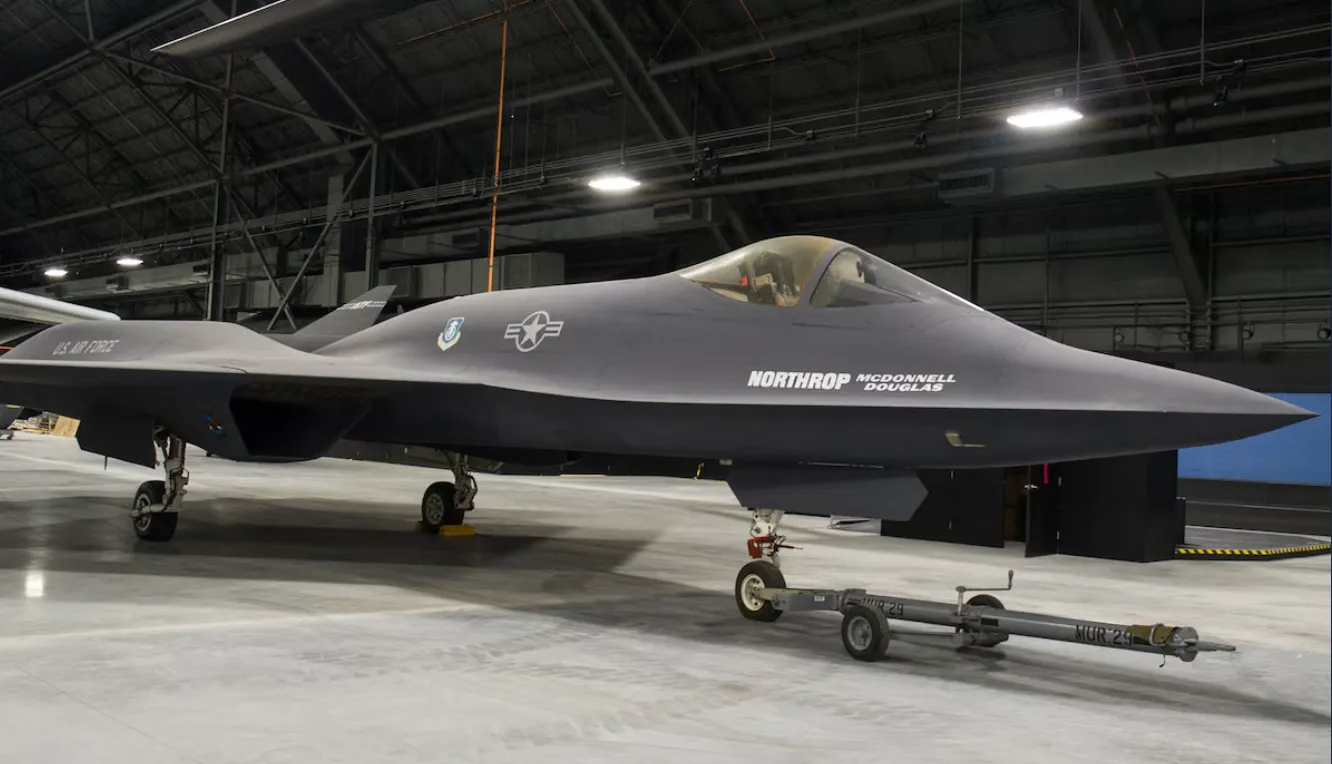
In this section, we’ll dive deep into the YF-23’s technical specifications, covering everything from its dimensions to its top speed and engine performance.
YF-23 Dimensions and Weight
| Specification | Value |
| Length | 67 feet 5 inches (20.6 m) |
| Wingspan | 43 feet 7 inches (13.3 m) |
| Height | 13 feet 11 inches (4.2 m) |
| Wing Area | 900 sq. feet (84 sq. meters) |
| Empty Weight | 29,000 lbs (13,154 kg) |
| Maximum Takeoff Weight | 62,000 lbs (28,123 kg) |
The YF-23’s large wingspan and diamond-shaped wing design contributed to its high-speed performance and low radar cross-section, allowing it to cruise at supersonic speeds while maintaining stealth.
The size of the aircraft also helped accommodate its internal weapons bay, which enhanced its stealth profile by keeping missiles and bombs hidden from radar detection.
YF 23 Top Speed and Performance
The Northrop YF-23 was designed to be one of the fastest jets in the world, capable of exceeding Mach 2 while also offering supercruise capabilities—the ability to sustain supersonic flight without the use of afterburners.
This feature made the YF-23 highly efficient for long-range missions, as it could cover large distances at high speeds without burning excessive amounts of fuel.
| Performance Metric | Value |
| Top Speed | Mach 2.2+ |
| Supercruise Speed | Mach 1.6 |
| Range | 800 miles (1,290 km) |
| Service Ceiling | 65,000 feet (19,800 meters) |
| Thrust/Weight Ratio | 1.14 |
The YF-23’s top speed of Mach 2.2+ made it one of the fastest jets of its time, rivaling even the YF-22 in terms of speed.
Its ability to supercruise at Mach 1.6 without afterburners was a significant advantage, as it allowed for more fuel-efficient flight at supersonic speeds, increasing its operational range.
YF-23 Engine Performance
The YF-23 Black Widow II was tested with two different engines during its development, both of which contributed to its impressive speed and stealth capabilities.
These engines were the Pratt & Whitney YF119 and the General Electric YF120. Each engine offered distinct advantages in terms of thrust and efficiency.
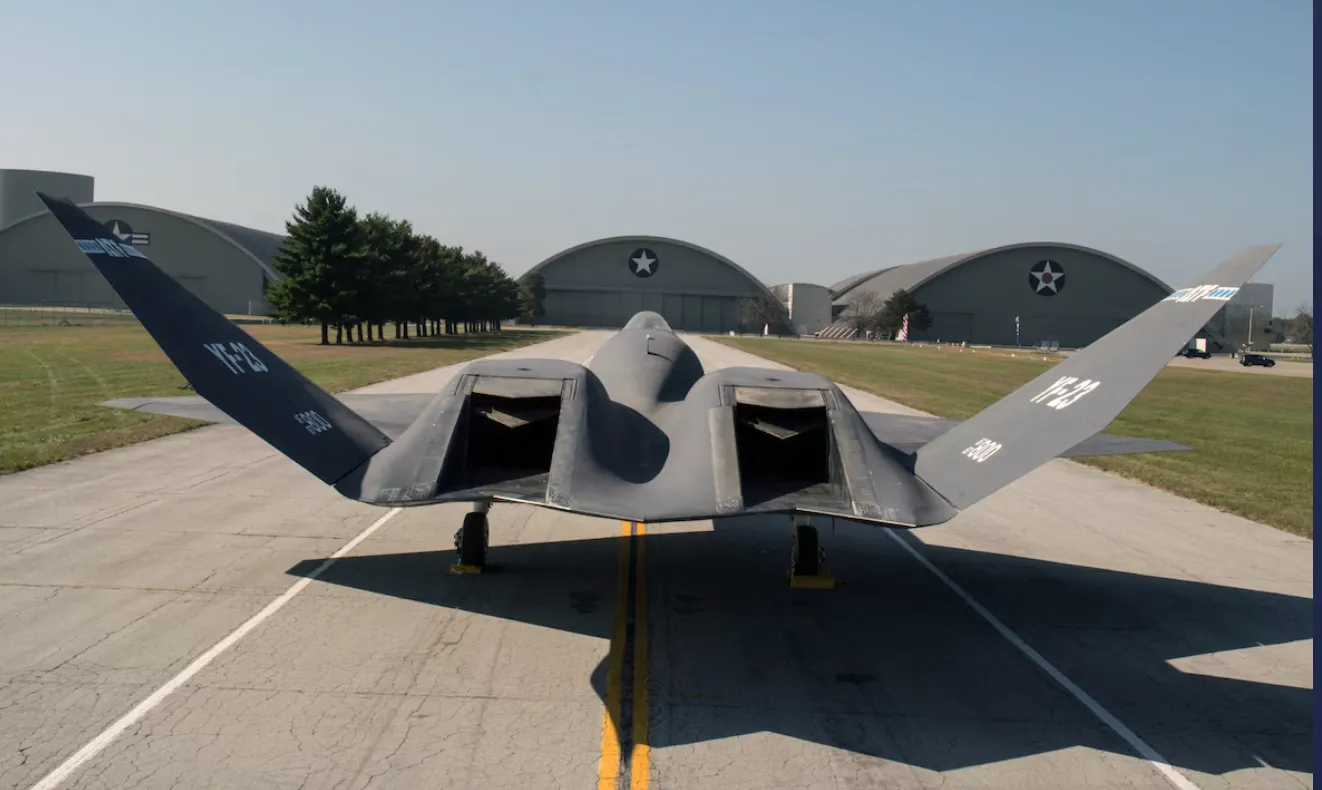
Pratt & Whitney YF119
- Type: Afterburning turbofan engine
- Thrust: 35,000 pounds (156 kN) with afterburner
- Special Feature: The YF119 engine was the more traditional of the two engine options, providing reliable high thrust with afterburning capability. It was later selected as the engine for the F-22 Raptor.

General Electric YF120
- Type: Variable-cycle afterburning turbofan engine
- Thrust: 35,000 pounds (156 kN) with afterburner
- Special Feature: The YF120 engine was a more innovative design, offering a variable-cycle capability that allowed it to switch between high-thrust and fuel-efficient modes. This gave the YF-23 an edge in terms of fuel economy and operational range.
The General Electric YF120 was seen as the more advanced of the two engines because it provided better overall fuel efficiency, which contributed to the YF-23’s supercruise ability. However, the Pratt & Whitney YF119 was ultimately selected for the F-22, likely due to its proven reliability and lower risk during the transition to production.
YF 23 Blueprint
The YF-23 blueprint is a highly sought-after item among aviation enthusiasts, historians, and model builders who are interested in understanding the intricacies of this advanced fighter jet.
The Northrop YF-23 Black Widow II was designed with a unique and stealth-optimized structure, and its blueprints offer detailed insights into its revolutionary aerodynamic design, stealth capabilities, and internal configurations.

Conclusion
The Northrop YF-23 Black Widow II remains one of the most fascinating aircraft ever developed, embodying a unique blend of stealth, speed, and advanced engineering.
While it ultimately lost the Advanced Tactical Fighter (ATF) competition to the YF-22, the YF-23’s influence on aviation history is undeniable.
From its sleek, diamond-shaped wings to its groundbreaking supercruise capabilities, the Northrop YF 23 was a technological marvel that pushed the boundaries of what was possible in military aircraft design.
Key Takeaways from the YF-23’s Legacy
- Advanced Stealth and Speed: The Northrop YF-23 was designed with stealth as a top priority, and its radar-evading capabilities were superior to many aircraft of its time. Coupled with its ability to supercruise at Mach 1.6, the YF-23’s top speed of Mach 2.2+ made it a formidable contender.
- Innovative Design: The YF-23’s diamond-shaped wings and V-tail configuration were not only aesthetically unique but also contributed to its stealth and aerodynamic efficiency. These features set it apart from its competition and continue to be studied and admired today.
- Technological Influence: Although it never reached mass production, the YF-23 Black Widow II influenced the development of modern stealth aircraft, including the F-35 Lightning II, B-21 Raider, and future 6th-generation fighters. Its technological innovations, particularly in stealth and propulsion, have had a lasting impact on the aerospace industry.
Share
Defense Feeds
Defense Feeds is publication focusing on informing, engaging, and empowering the world by providing accurate information from defense technology.
Powered by Defense Feeds © 2025 – All rights reserved.




